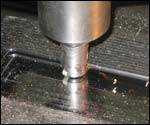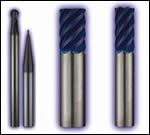How to Choose the Best Tools For Rework and Repair
Pointers specifically for where hard welds need to be milled.
The best tool to use for rework or repair follow the same rules as making the initial mold. The only difference is the condition of the material you are cutting. Speeds, feeds and cutting parameters might need to be adjusted depending on the hardness and condition of the weld.
Choosing the proper cutting tool is very important when machining hardened metal. There are three basic designs of cutters: (1) ball end (2) corner radius (bullnose) and (3) square end (see Figure 1).
The first choice in hard metal machining should be the ball end mill. The ball end mill should be used for roughing operations and most finishing operations. Its large radius dissipates the force and heat that is generated in cutting hard material at high speeds and feeds. The ball end mill allows the user to cut closer to the net three-dimensional shape and allows for higher speeds and feeds.
If a part requires large, flat areas on its floor, a corner radius tool should be used after the ball end tool has roughed out the part. The corner radius tool does not have as large of a radius as the ball; and therefore, does not dissipate the heat and force as well as the ball end mill.
The square corner tool should be used as a last resort and only after a ball end and corner radius tool has removed as much material as possible from the part.
The sharp corner of a square end tool acts as a focal point for all the heat and force and will have a tendency to chip. The only time a square end mill should be used is when a sharp corner is required at the transition of a floor and a wall.
Tool rigidity also is an important factor to consider. In small diameter cutters the shank of the tool should be much larger than the cutting diameter (Figure 1). This increases the stiffness of the cutter, which helps produce better finishes and affords longer tool life.
It is important to choose the tool to fit the application as closely as possible. For example, some end mills for die/mold machining come with an eight-degree per side draft angle. Yet at the factory it is very easy to modify this angle and can be done very quickly.
If the part has three-degree draft, the tool can be modified to 2½-degree draft. Generally, a tool should have one-half degree less draft than the actual part. This one-half degree provides for angular clearance while keeping the tool as strong as possible (see Figure 2).
Additionally, the tool should not project from the holder any further than is required. If straight walls are required, a neck can be utilized to strengthen the tool (see Figure 3). Both methods allow the short-length-of-cut tool to cut deeper than its cutting length.
Related Content
-
Understanding Manifold Thermal Expansion
Molders, mold builders and repair technicians must fully understand thermal expansion to ensure they don’t damage critical seals during manifold repairs or routine cleanings.
-
How to Use Scientific Maintenance for More Accurate Mold and Part Troubleshooting
Discover how adopting scientific maintenance approaches helps improve mold lifespan, minimize failures, and optimize production outcomes.
-
What You Need to Know About Hot Runner Systems and How to Optimize Their Performance
How to make the most out of the hot runner design, function and performance.

















